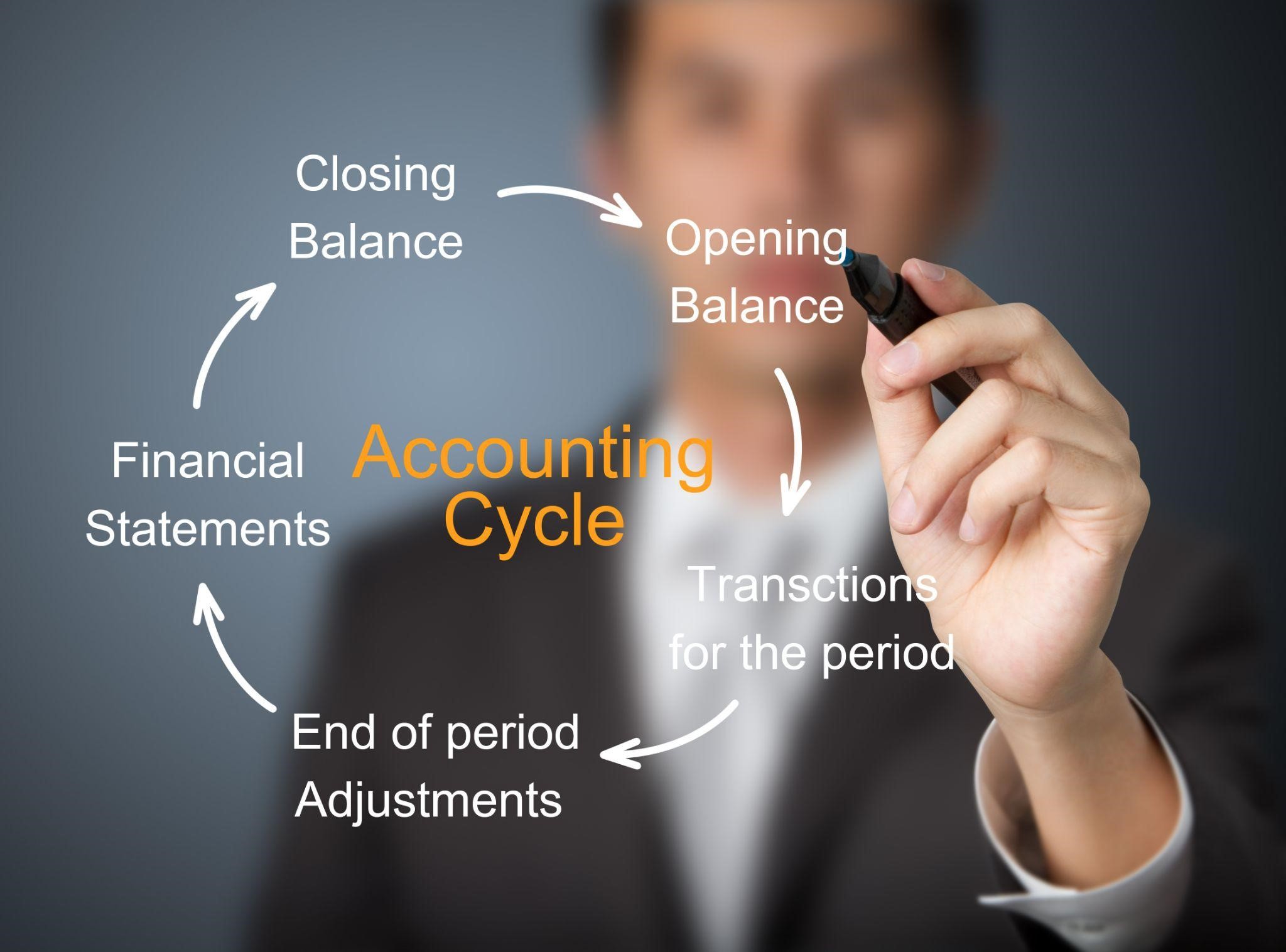Accounting Cycle – Benefits, Limitations, Working with 5 Important Steps

Businesses balance their books by analysing, identifying and sorting their accounting activities. This process is usually termed an accounting cycle. However, accounting cycle is not as simple as it sounds. There are multiple steps involved, limitations, time period, etc., in an accounting cycle.
However, for everyone’s ease of understanding, we have simplified how the accounting cycle works. Let’s dive in!
What is an Accounting Cycle?
The financial process of recording, processing and sorting financial data of a business or an organisation during a financial year is called accounting cycle. Depending on the production scale, accountants may choose to balance their financial books quarterly, monthly or yearly.
Accounting cycles assist an organisation in recording its financial statements like cash flow, inventory valuation, profit and loss statements, balance sheets, etc. Balancing such information on the credit and debit side is useful for analysing the effect of each variable on different accounts and assessing annual performance.
To better explain the accounting cycle, experts believe it is a quintessential analytical tool to judge internal and external stakeholders’ business decisions. A bookkeeper or accountant records all such information for a financial year.
How Does Accounting Cycle Work?
The accounting cycle is a consolidated account of the financial performance of an organisation. To ensure the accuracy and legitimacy of these accounts, companies may use dedicated accounting systems to reduce mathematical errors.
Accountants follow the accounting cycle steps by recording all financial variables in fully automated computerised accounting systems. They can also acquire a graphical representation of the financial statistics and identify methods to improve them.
5 Steps in the Accounting Cycle
An accounting cycle records all information responsible for tracking financial efficacy. The accounting cycle steps include:
1. Managing Transactions
Business organisations manage their production process by keeping track of their budget, expenses and working capital. The accounting cycle starts with keeping a record of all transactions, including purchasing or acquiring assets, revenue from sales, debt payoffs, etc.
2. Journal Entries and General Ledgers
Recording transactions in the organisation’s financial journals is the next legitimate step. It involves balancing the credit and debit balances. These entries are then documented in the general ledger to summarise all individual financial transfers.
3. Trial Balance and Worksheet Management
Towards the middle of an accounting cycle, organisations calculate the total balance for the individual accounts. In case the credit and debit balances do not match, the accountant must look for errors and make appropriate adjustments on the worksheet.
4. Adjusting Entries and Managing Annual Financial Statements
All accruals and deferrals are henceforth adjusted at the end of the accounting period. To mark the end of an accounting cycle, companies prepare the final balance sheet and cash flow statements.
5. Annual Account Closing
To make way for a fresh accounting cycle, companies close and zero out all expense and revenue accounts. Since they reflect the company’s annual performance, it is crucial to close them. However, balance sheets remain open because they are indicators of the company’s financial performance at a particular time.
Also Read
Illustration of Accounting Cycle with an Example
To better understand the steps mentioned above, take the example of a manufacturing company dealing with 3rd party automobile parts. They begin their accounting cycle by receiving Rs.80,000 in sales on their brake callipers and fluids. This information is recorded in the chronological order of transaction entries.
Now journal entries record a financial credit/debit on the date it occurs. Thus, the above transaction implies a debit of Rs. 80,000 to cash and credit of Rs. 80,000 to sales revenue. The next step involves calculations on the general ledger. Consider the following transactions and their inception into the general ledger.
Sale of brake callipers and fluids – Rs. 80,000
Sale of titanium exhausts mufflers – Rs. 50,000
Cash refund extended to a customer purchase – Rs. 10,000
Net summarised cash transactions = Rs. 80,000 + Rs. 50,000 – Rs. 10,000 = Rs. 1,20,000.
Note that companies treat refunds differently depending on their treatment of sales and revenue. Some may treat the summarised sales revenue by adding the sales amounts while keeping a separate contra account to offset regular revenues with a debit account.
What are the Benefits of Accounting Cycle?
Accounting cycles help entities to realise the true value of a business venture. The balance sheet, for example, measures the values of assets and liabilities to have a systematic record of transactions. The end of a financial year tabulates these records and helps companies make reinvestment, hiring and other business decisions.
Some of the advantages of managing an accounting cycle are:
1. Judging Financial Performance
A well-organised accounting cycle helps analyse business performance and highlights the effectiveness of a particular financial strategy.
For example, a company might hover around its financial performance and discover the need to hire more employees for a new division they have started. Thus, an effective accounting cycle makes the company ready for future investments.
2. Raising Capital
An accounting cycle indicates a business’s trustworthiness. Financial statements are the key to determining their future interest if there are multiple shareholders in a business.
3. Compliance
Business organisations must follow certain rules and regulations according to federal business laws. For example, tax deductions are calculated based on the parameters in financial statements. Any errors in the statements made in the current accounting cycle will pose potential problems at the end of the financial year.
Limitations of the Accounting Cycle
The primary aim of an accounting cycle is to include all financial information in the general ledger. Balancing all financial statements is critical since any mismatch in these figures will lead to financial miscalculations and penalties.
Problems in financial accounting may lead companies to diverge from the actual business plans. Errors in recording entries may lead to unnecessary discrepancies that can upset a firm’s top decision-makers.
Experts believe accountants may make general mistakes leading to astronomical errors in the accounting cycle. Some common limitations of the accounting cycle include:
1. Measurability
Business organisations often deal with events that do not have a monetary value. Factors like management, loyalty and reputation do not directly contribute to profit making. Hence, accounting cycles cannot measure such variables, although they are crucial.
2. No Space for Future Assessment
Financial statements represent the financial position of the current accounting cycle. Accounting cycles do not make future estimates. Since business organisations work on the dynamic nature of the economy, it is impossible to make future predictions based on the data from financial statements.
3. Diverse nature of accounting policies
Accounting standards are different for different economies. Thus, the Indian accounting standards do not necessarily share common characteristics with the American standard. Moreover, accountants use historical data to strike a balance between the adopted policies and what lies ahead. Thus, it often omits factors like inflation, unemployment and economic shocks.
4. Verifiability and Room for Fraudulent Activities
An accounting cycle verifies its existence during an audit. However, auditing is not always free from errors and misjudgement. Moreover, the efficacy and applicability of financial accounting may suffer due to possible manipulations. Innumerable cases of duplicitous activities are subsided by manipulated accounting.
Time Period of the Accounting Cycle
An accounting cycle keeps track of financial information during a particular time period. Normally, companies engage in accounting cycles ranging from a fiscal year to a quarter or month-wise.
Accounting cycles pertaining to a calendar year begin with accounting financial information from the 1st week of January till the last week of December. Some companies also identify their financial strength during a financial or fiscal year (1st April to 31st March).
To experience consistency in accounting and ensure long-term profitability, companies generally follow an accrual method of accounting. This ensures considering economic activity irrespective of the cash disbursal.
How is the Accounting Cycle Different from the Budget Cycle?
Accounting cycles are not the only form of recording and analysing financial transactions. Budget cycles are essential to record and analyse budget-based transactions that a company might consider for future ventures. However, both these statistics differ from each other in their intrinsic definition.
Accounting cycles summarise and analyse financial information, the results of which are shared with shareholders. This increases their likeability and potential to gain future projects. Budget cycles, however, constitute a company’s internal financial information that helps entrepreneurs take future decisions.
Things to Know About the Accounting Cycle
Here are some of the primary things one should know about accounting cycles:
- Accounting cycle is a collective process that identifies, analyses and records all the financial transactions of a company.
- There are primarily 8 steps in an accounting cycle. However, some organisations also follow the 5-step or 10-step accounting cycles as per their needs.
- The duration of an accounting cycle starts from the beginning of an accounting period and ends when all financial statements have been prepared.
- The financial statements generated at the end of an accounting cycle include a balance sheet, income statement and cash flow statement. Many companies also include various internal reports.
Final Word
Managing the finances of an organisation determines its profit-making capabilities. From analysing transactions to closing all temporary accounts during an accounting period, accounting cycles document and analyse past transactions. Thus, it paves the way for handling finances efficiently.
FAQs on Accounting Cycle
Ans. Accounting cycles consist of several steps, including recording transactions, transferring to ledgers, trail balancing and statement analysis, etc. These steps ensure that the company understands its finances well and does not fall prey to adverse situations. Thus, these steps are performed repeatedly depending on the accounting period.
Ans. All internal and external stakeholders depend on accounting cycles for judging a firm’s financial stability. It helps them make investment decisions or make future hiring decisions. Moreover, it also determines their acceptance of future growth plans of the organisation.
Ans. The efficacy of a company in generating cash from its regular operations is represented in the cash flow statement. It includes both the balance sheet and the income statement. At the end of every financial year, it helps determine how cash-efficient the company is.
Ans. Financial statements are indicators of a company’s financial strength. One can understand the revenue inflow, expenses incurred and cash management of an organisation by assessing financial statements.
Ans. The purpose of accounting is to ensure that all the funds coming in or going out of a business is accounted for. This process requires constant balancing and adjustments so that the debits and credits match. This is why the process of accounting becomes a cycle that starts again at the beginning of the next assessment/fiscal year.
Disclaimer
This article is solely for educational purposes. Navi doesn't take any responsibility for the information or claims made in the blog.

Customer’s Feedback
No comments found.10 Best Bank for Savings Account in India [Highest Interest Rate 2023]
Savings account is a type of financial instrument offered by several banks. It lets you safely depo... Read More »What is Issuer Identification Number (IIN)- Working and Importance
What is an Issuer Identification Number (IIN)? Banks and financial institutions assign a distinc... Read More »What is a Vostro Account – Meaning, Working and Difference
What is a Vostro Account? A Vostro account is a bank account held by a domestic bank on behalf o... Read More »What is a Solvency Certificate? – Format, Documents Required & How to Apply Online?
What is a Solvency Certificate? A solvency certificate is a legal document furnishing the detail... Read More »What is Merchant Banking – Services, Features, Functions and Example
What is Merchant Banking? Merchant banking is a set of select banking and financial services off... Read More »Automated Clearing House: Objectives, Types and Process
Automated Clearing House is an electronic fund transfer network that manages automatic and direct... Read More »How to Redeem Credit Card Reward Points ?
Credit Card Reward points are types of incentives that customers receive when they use a credit car... Read More »What is Electronic Clearing Service (ECS) in Banking and How does it Work?
What is Electronic Clearing Service (ECS)? Electronic Clearing Service (ECS) is a method of elec... Read More »What are Credit Card Validators and How to Use them?
What is a Credit Card Validator? A credit card validator is a tool that checks the validity of a... Read More »What is Cash Management and How Does it Work?
Managing available capital can make sure that a small business stays afloat. Cash management is an ... Read More »What are Prepaid Expenses? – Definition, Examples, and Journal Entry
Prepaid expenses represent payments made in advance for products or services expected to be incurre... Read More »Increase Credit Card Limit – Important Tips and How to Do It?
The credit card limit is the maximum amount of money you can spend using your credit card. Your cre... Read More »Top 10 Chit Fund Schemes in India in 2023
Chit funds are one of the most popular return-generating saving schemes in India. It is a financial... Read More »10 Best Gold ETFs in India to Invest in April 2023
Gold ETFs or Gold Exchange Traded Funds are passively managed funds that track the price of physica... Read More »10 Best Demat Accounts in India for Beginners in 2023
Creation of Demat accounts revolutionised the way trades were conducted at the stock exchanges. It... Read More »20 Best Index Funds to Invest in India in April 2023
What is an Index Fund? An index fund is a type of mutual fund or exchange-traded fund (ETF) that... Read More »Best Arbitrage Mutual Funds to Invest in India in April 2023
Arbitrage funds are hybrid mutual fund schemes that aim to make low-risk profits by buying and sell... Read More »10 Best SIP Plans in India to Invest in April 2023
What is SIP? SIP or Systematic Investment Plan is a method of investing a fixed amount in ... Read More »10 Best Corporate Bond Funds in India to Invest in April 2023
Corporate bond funds are debt funds that invest at least 80% of the investment corpus in companies ... Read More »10 Best Bank for Savings Account in India [Highest Interest Rate 2023]
Savings account is a type of financial instrument offered by several banks. It lets you safely depo... Read More »































